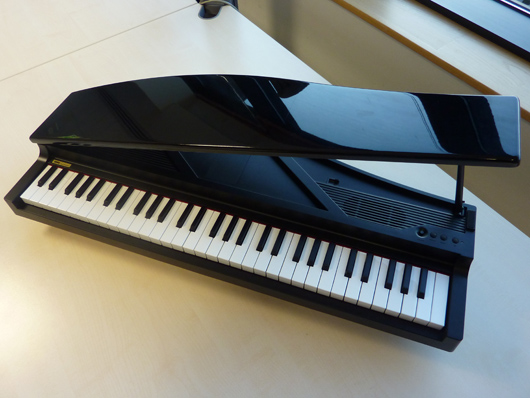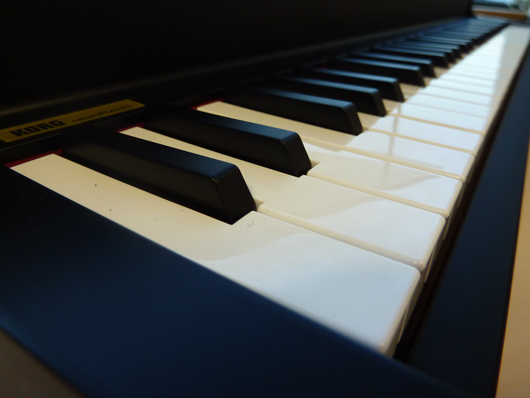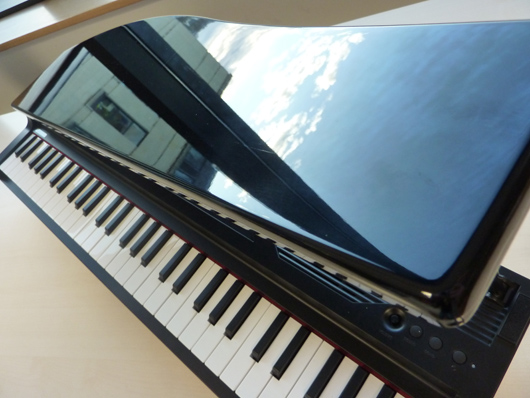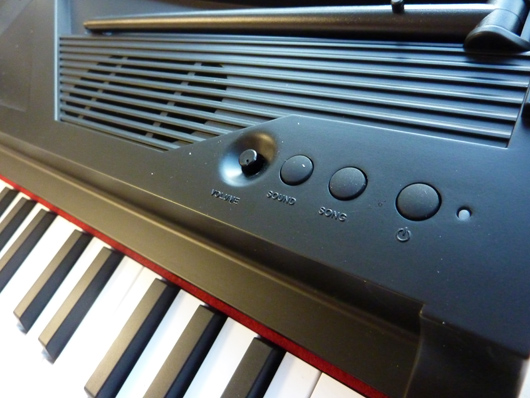FIRST LOOK: Korg microPiano

Little wonder
It’s like a grand piano, but really small. Your level of appreciation for the latest addition to Korg’s micro range (see also the microKorg, microKorg XL, microSampler, microStation and microKey) will almost certainly depend on how much you’re willing to buy into that concept; some will be baffled by the very existence of the microPiano, which retails for £399, while others will see it once and immediately want to own it.
Which camp do we fall into? Let’s take a closer look and find out…
NEXT: How does it play?

The keys
This being a product from Korg’s micro range, the microPiano’s keys are mini rather than full-size. However, you do get 61 of them - enough for you to express yourself - and, thanks to the implementation of Korg’s Natural Touch technology, they’re much more playable than those that you’ll find on some cheap mini MIDI controllers.
That said, those with big sausage fingers may struggle to play the microPiano with much proficiency. Keyboardists who have spindly, nimble digits are definitely at an advantage when it comes to using it.

The sounds
We’ve got no complaints here: the microPiano sounds like a proper digital piano. Electric pianos, organs and other ‘traditional’ instruments are covered too, though synths are conspicuous by their absence.
61 sounds are included, with some of these being short phrases that can be triggered by pressing and holding a key. There are also 40 songs that can be played back using whichever sound you like.
It’s worth pointing out that there are no sound editing options: what you hear is what you get.
Listen to a selection of the microPiano’s sounds:
Grand Piano
Tine E.Piano
Electric Organ
Snow Crystal

Design and build
Let’s face it - the microPiano looks cute. In fact, its novel appearance is bound to be one of the reasons why a lot of people invest in it.
The big talking point is the lid, which can be propped up to reveal the speakers, controls and battery compartment (it takes six AAs or can be mains powered). Having this up does have a slight impact on the tone of the instrument, though it’s hard to say whether it makes it sound better or worse.
The microPiano’s speakers are just about powerful enough to fill a room, though we did encounter a little bit of rattling from them when playing certain sounds at higher volume levels.
The lid itself feels solid and has a nice shiny (though easily scratchable) finish. We had it in black, but it’s also available in red and white. The rest of the case, however, is plastic, which does cheapen the overall effect.
One point to make is that the controls can only be accessed when the lid is up, so if you’re going to need to adjust the volume or change the sound during your performance, that’s the way it will have to be.
What’s more, because sounds/songs are selected with a combination of a button and key press and there’s no display, you need to keep the reference sheet handy (unless you’re able to memorise which sounds/songs correspond to which key, that is).

Connectivity
Here’s the bad news: the microPiano doesn’t offer much in the way of inputs and outputs. The only audio output is a headphone mini-jack (this overrides the built-in speakers), and then there’s just a damper pedal input and a socket for the power supply.
Which means there’s no MIDI, either over a standard port or USB. This will be a deal-breaker for some, who may very well want to use the microPiano on its own for the majority of the time, but would also like the option of hooking it up to their computer or other MIDI gear. It seems a strange oversight.

Summary
The microPiano is more than just a toy - though it will delight children - but as we said at the outset, ultimately, you’ll either like the idea of owning a miniature grand piano or you won’t.
We can certainly see the attraction of having a decent-sounding, portable instrument that you can just turn on and play, though the big compromise is the mini keyboard. It’s a shame that sound selection isn’t more obvious and intuitive (though you’ll probably memorise the locations of your favourites), but we can understand Korg wanting to limit the amount of control furniture on the unit so as to maintain its grand piano-like appearance. The lack of a MIDI output on the back panel is less forgivable.
Would you play this at a gig? Possibly not, though anyone who performs on a microPiano is guaranteed to raise at least one smile from their audience. However, the instrument is more likely to become a fixture in your living room, and based on the reaction it got when we were playing it in the office, it’s sure be a talking point.
Ultimately, the world probably wouldn’t have missed the microPiano if Korg hadn’t bothered to invent it, but we’re glad that it did.
Liked this? Now read: In pictures: FIRST LOOK: Korg microKey
Connect with MusicRadar: via Twitter, Facebook and YouTube
Connect with Rhythm: via Twitter and Facebook
Get MusicRadar straight to your inbox: Sign up for the free weekly newsletter

I’m the Deputy Editor of MusicRadar, having worked on the site since its launch in 2007. I previously spent eight years working on our sister magazine, Computer Music. I’ve been playing the piano, gigging in bands and failing to finish tracks at home for more than 30 years, 24 of which I’ve also spent writing about music and the ever-changing technology used to make it.